7 Best Latin Courses for Beginners in 2025
Keep Latin alive with our handpicked list of the best Latin courses and resources for self-taught and home-schooled students.

Quick Access:
- Resources for Beginners: Foundational Course, Popular and Free, Resources for Absolute Beginners, Also Great Beginner Course, With Free Certificate
- More Resources: In Italian, Immersive Latin
What do the words succeed, agenda, and scholar have in common? If you answered “They all come from Latin,” you’d be right. Hundreds of English words have come from Latin, both directly during and after the Roman occupation and indirectly via other European languages.
I’ve explored over 50 Latin courses, books, and websites, and have chosen the seven best Latin online courses and resources for this Best Courses Guide.
Click on the shortcuts for more details:
- Top Picks
- What is Latin?
- How to Learn Latin
- Resources Overview
- More Free Resources
- Why You Should Trust Us
- How We Made Our Picks and Tested Them
Here are our top picks
Click to skip to the course details:
| Course Highlight | Workload |
| Best Foundational Latin Course (Udemy) | 4-5 hours |
| Most Popular Free Short Latin Course (latintutorial) | 1-2 hours |
| Also Great Beginner Latin Course (Udemy) | 18 hours |
| Best Latin Book and Site for Absolute Beginners (William E. Linney) | 192 pages |
| Best Beginner Latin Course with Free Certificate (The Open University) | 10 hours |
| Best Course in Italian About Learning Latin (University of Naples Federico II) | 36-48 hours |
| Also Great Latin Learning Book Series (Hans Ørberg) | 328 pages |
What is Latin?
Latin is a classical language that originated in the region of Latium in ancient Italy around 700 BC. It belongs to the Italic branch of the Indo-European language family.
Originally spoken by small groups living along the lower Tiber River, it spread with the expansion of Roman power throughout Italy and eventually across much of western and southern Europe.
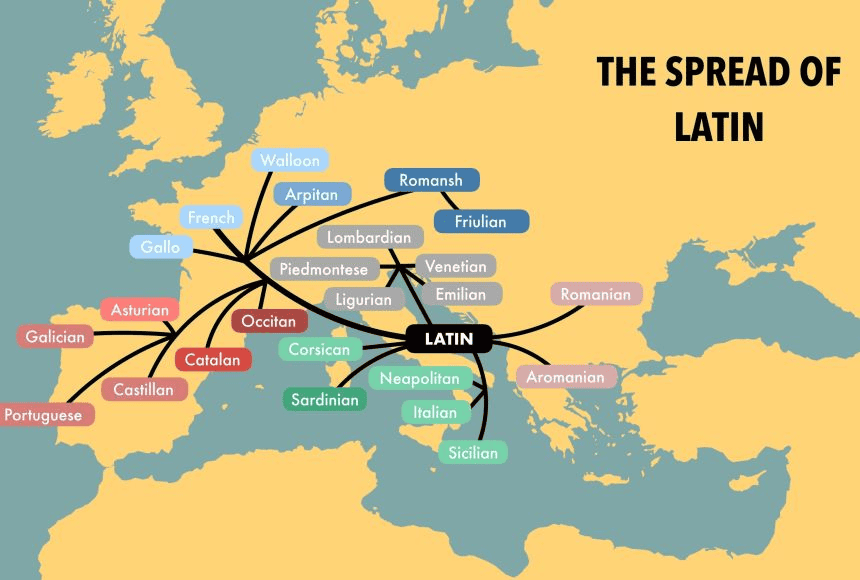
During the Classical period (75 BC onwards), Latin became standardized and was the dominant language of the Roman Empire, evolving from Old Latin into Classical Latin, and later into Vulgar Latin, which gave rise to the modern Romance languages: French, Spanish, Italian, Portuguese and Romanian. Even after it ceased to be a native spoken language, Latin remained important as a language of religion, scholarship, and administration in Europe well into the 19th century.
Latin is considered a “dead language” as it no longer has native speakers. However, it remains the official language of Vatican City and is still studied widely. It has greatly influenced many modern languages, especially English, contributing significantly to their vocabularies. Some estimates suggest up to 60% of English words have Latin or Greek roots, with a significant portion being Latin. However, it’s important to note that many of these words entered English through other languages, particularly French, rather than directly from Latin. The Latin alphabet, derived from the Etruscan alphabet, is now the most widely used alphabetic writing system in the world.
Latin’s legacy continues through its descendants (the Romance languages), its use in scientific and medical terminology, and its ongoing study in academic and religious contexts.
How to Learn Latin
Like learning any language, practice and repetition are key. Make flashcards and explore a range of resources including courses, books, websites, and apps. Look for comprehensible input – texts that are just slightly above your current level to challenge you without being overwhelming.
Practice daily, even if just for 15 minutes. Consistent exposure is key for language learning. Space out your practice sessions. Studying for shorter periods more frequently is better for retention than longer, less frequent sessions. Make flashcards (with actual cards or a phone app) to carry around and use for practice anywhere, anytime.
Focus on reading and understanding Latin from the beginning, rather than just memorizing grammar rules and vocabulary lists. Take advantage of Latin’s regularity and its connection to English. Many English words derive directly or indirectly from Latin, which can help you remember vocabulary.
If you learn about Roman culture and history alongside the language, it will provide context and can help maintain motivation.
Use active learning techniques like speaking Latin aloud, writing in Latin, and immersing yourself in the language as much as possible. Regularly translate and read Latin texts to improve your skills, and use mnemonic devices like songs or chants to remember noun declensions and verb conjugations.
Remember, consistency and patience are key when learning any language, including Latin. Don’t be discouraged if progress seems slow at first – with regular practice, you’ll gradually build your skills and understanding.
Resources Overview
- Three resources are free or free to audit and four are paid
- Two courses offer a certificate of completion (one free, one paid)
- The Latin subject is followed by 2.9K learners on Class Central
- The most featured provider is Udemy with two courses.
Best Foundational Latin Course (Udemy)

The beginner’s course, An Introduction to Classical Latin, covers the fundamentals of reading, writing, and understanding Latin. It serves as an excellent foundation for learning Romantic languages and enhances understanding of English etymology and grammar. The course has concise lectures, comprehensive materials including regularly updated vocabulary lists, and regular self-assessment opportunities with answer keys.
In this course, you will:
- Learn to read and write Latin
- Memorize a large vocabulary of Latin words
- Understand basic Latin grammar and syntax
- Explore the etymology of English words derived from Latin
- Gain insights into the grammar of your own language through Latin.
“Very well explained with perfect pace, review at the end of each lesson as well as examples of how to speak.” – Luis Antonio Gagliardi P., Udemy learner.
| Provider | Udemy |
| Instructor | Benedict Atchley |
| Workload | 4-5 hours |
| Enrollment | 6.6K |
| Rating | 4.8/5.0 (977) |
| Cost | Paid |
| Quizzes/Assessment Items | Exercises and self-test exams |
| Certificate | Paid |
Most Popular Free Short Latin Course (latintutorial)
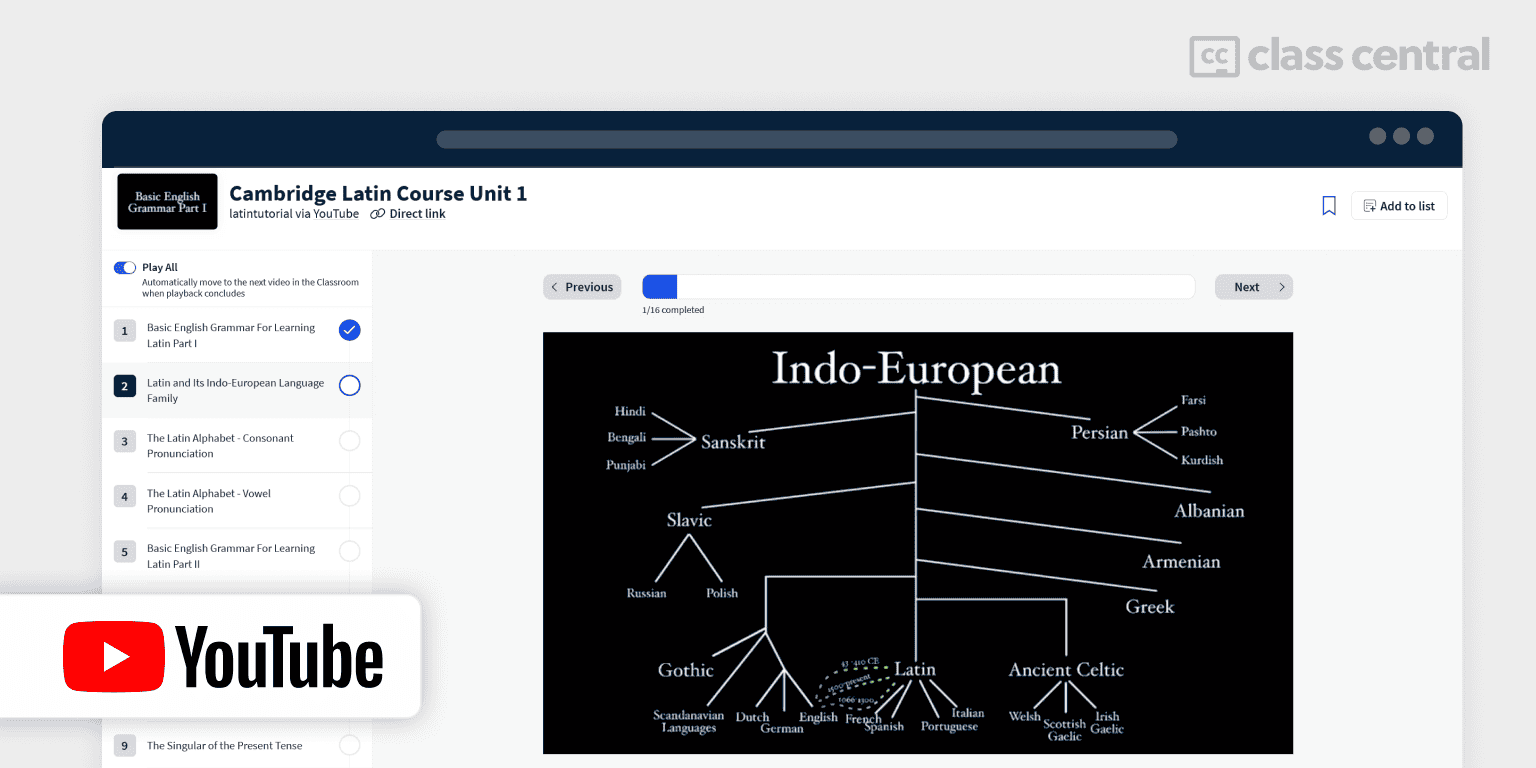
Cambridge Latin Course Unit 1 is designed to help students learning Latin focus on understanding grammar essentials. The course covers the basics of the Latin language, crucial for reading and understanding stories about characters including Caecilius, Quintus, and Grumio.
Syllabus:
- Basic English grammar for learning Latin
- Latin and its Indo-European language family
- The Latin alphabet – consonant and vowel pronunciation
- Nominative and accusative cases
- Basic Latin word order
- Basics of declension
- Subjectless and irregular verbs
- Tenses: singular and plural, present, perfect, imperfect
- Superlative adjectives
Other courses from latintutorial include:
- Basic Latin Essentials (2-3 hours)
- Latin Verbs (6 hours)
- Latin Nouns, Pronouns, and Adjectives (6 hours)
“Three and a half minutes and I’ve got my best class ever!…Thank you so much! GRATIAS TIBI AGO!” – keuzacosta1497, YouTube learner.
| Provider | YouTube |
| Channel | latintutorial |
| Workload | 1-2 hours |
| Views | 879K |
| Cost | Free |
| Quizzes/Assessment Items | Not available |
| Certificate | Not available |
Also Great Beginner Latin Course (Udemy)
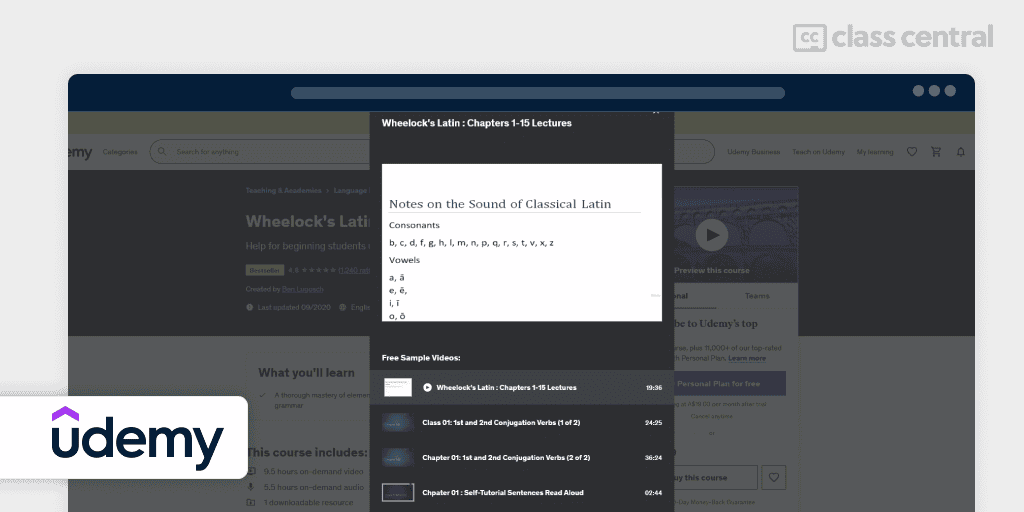
Wheelock’s Latin : Chapters 1-15 Lectures is designed to assist beginners using the renowned Wheelock’s Latin textbook. By complementing the textbook, the course provides clarity on complex grammar concepts in both English and Latin. While the lectures supplement the Wheelock text, they don’t replace it and do not provide answers to the exercises. This course is ideal for students seeking a structured approach to mastering the basics of Latin.
Syllabus:
- Introduction to basic concepts of Latin grammar
- Review and application of English grammar concepts as they relate to Latin
- Detailed walkthrough of Wheelock’s textbook chapters 1-15
- Guidance on self-tutorial exercises found in the Wheelock book
- Overview of classical Latin pronunciation as accepted by modern scholars
- Additional resources for progressing to intermediate Latin prose
- Information on further courses for advanced Latin studies, including AP Latin texts
Ben also has courses that cover the rest of Wheelock’s book:
- Wheelock’s Latin : Chapters 16-30 Lectures (11 hours)
- Wheelock’s Latin: Chapters 31-40 Lectures (5 hours)
“Excellent course. A dream come true. Something I can follow along at my own pace and with a very good instructor. I highly recommend this course.” – Gabriel R., Udemy learner.
| Provider | Udemy |
| Instructor | Ben Lugosch |
| Workload | 18 hours |
| Enrollment | 8.6K |
| Rating | 4.8/5.0 (1.2K) |
| Cost | Paid |
| Certificate | Paid |
Best Latin Book and Site for Absolute Beginners (William E. Linney)
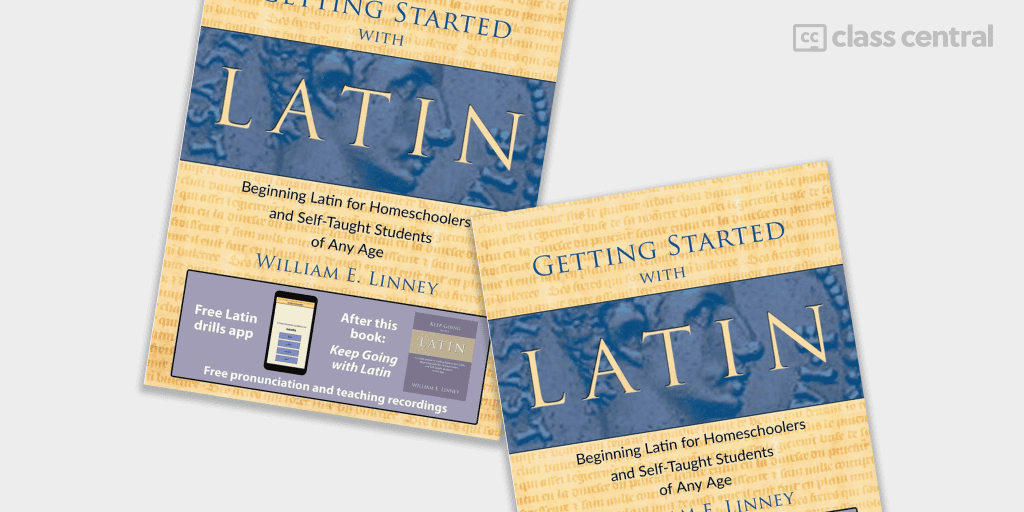
Ideal for self-taught and home-school Latin students, I can personally vouch for this book’s suitability for beginners. Paired with free audio recordings, free apps, and YouTube videos to help with pronunciation, Getting started with Latin is an excellent, easy-paced book.
It’s divided into simple lessons that explain the fundamentals of Latin grammar and compares them to English usage. New words and concepts are introduced gradually with plenty of spaced repetition. You can immediately apply what you’ve learned by translating the fun exercises in each lesson and check your work by turning to the included answer key. To hear the words pronounced, simply download the free recordings from www.GettingStartedWithLatin.com and check the extensive audio commentary recordings that cover every lesson and exercise in the book.
And when you’ve worked through Getting Started with Latin, move onto Keep Going with Latin for a strong foundation before tackling harder courses.
“…If you’re a complete beginner…start with this book! It will save you loads of frustration. Once you get through this book and the second, you’ll be well set up for moving on to the harder textbook….” – cmykarr, Amazon reviewer.
| Publisher | Armfield Academic Press |
| Author | William E. Linney |
| Workload | 192 pages |
| Rating | Amazon 4.7/5.0 (1.7K) Goodreads 4.3/5.0 (445) |
| Cost | Paid |
| Quizzes/Assessment Items | Practice exercises throughout |
| Certificate | Not available |
Best Beginner Latin Course with Free Certificate (The Open University)
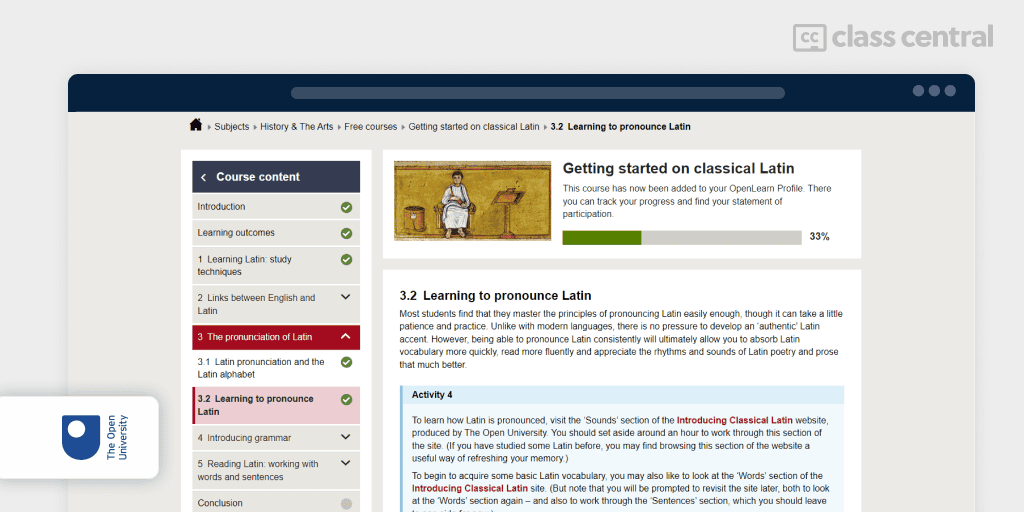
Getting started on classical Latin is a free, introductory 10-hour course designed for beginners with no prior experience in Latin, providing a foundation in the basics of the language and its historical influence on English. The course includes a glossary and aims to prepare learners for further study in classical languages.
Syllabus:
- Learning Latin: study techniques
- Links between English and Latin: the Roman empire, Norman French, the Renaissance, the modern era
- Latin vocabulary, pronunciation and the Latin alphabet
- Grammar: inflection, parts of speech, sentences
- Unravelling sentences (English prose and poetry: subjects and objects)
- Reading Latin: working with words and sentences
- Cases in Latin (Nominative, Accusative, Summary of cases).
Other Latin courses from The Open University:
- Continuing classical Latin (4 hours)
- Discovering Ancient Greek and Latin (12 hours)
“Really enjoyed this course from the way it is structures (sic) to the interactive style of learning. It really helped what I learnt stick more!
I recommend keeping a notebook with you while learning just to jot down what you learn and make notes especially with the whole subject-object-verb section! ” – Niamh Sharpe, OpenLearn learner.
| Provider | OpenLearn |
| University | The Open University |
| Workload | 10 hours |
| Rating | 4.5/5.0 (74) |
| Cost | Free |
| Quizzes/Assessment Items | Practice exercises |
| Certificate | Free |
Best Course in Italian About Learning Latin (University of Naples Federico II)
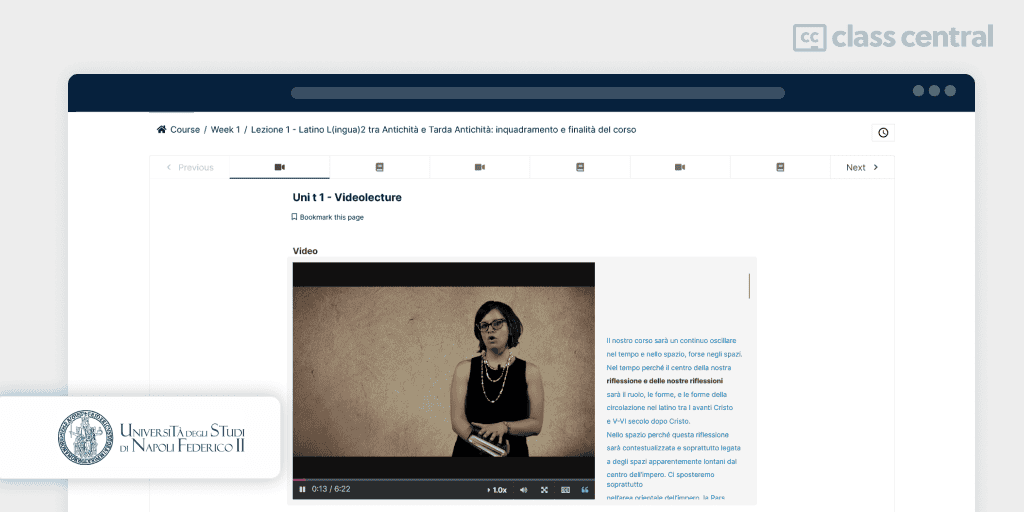
Imparare il latino attraverso lo studio dei papiri explores the teaching and spread of Latin in the Eastern Roman Empire from the 1st century BC to the 6th century AD, using direct evidence from papyri, parchment fragments, wooden tablets, and potsherds. The course delves into the phenomena of bilingualism (Latin-Greek) and diglossia, examining how Latin was perceived and taught as a second language in antiquity and late antiquity.
Course Syllabus:
- Introduction to the study of Latin through papyri
- Historical context of Latin in the Eastern Roman Empire
- Analysis of direct evidence from papyri and other materials
- Study of bilingualism and diglossia in the Eastern provinces
- Examination of Latin as a second language (L2) in antiquity
- Reflection on the teaching methods and perception of Latin during the period
- Conclusion and implications for understanding ancient linguistic practices
“Excellent course, with comprehensive coverage of the archeological and textological data on manuscripts related to transmission and distribution of the Latin language mostly in hellenophonic regions of the Roman Empire from antiquity to middle ages…” – George Belov, Class Central learner.
| Provider | edX |
| University | University of Naples Federico II |
| Instructor | Maria Chiara Scappaticcio |
| Language | Italian |
| Workload | 36-48 hours |
| Cost | Free audit |
| Quizzes/Assessment Items | Free practice questions |
| Certificate | Paid |
Also Great Latin Learning Book Series (Hans Ørberg)
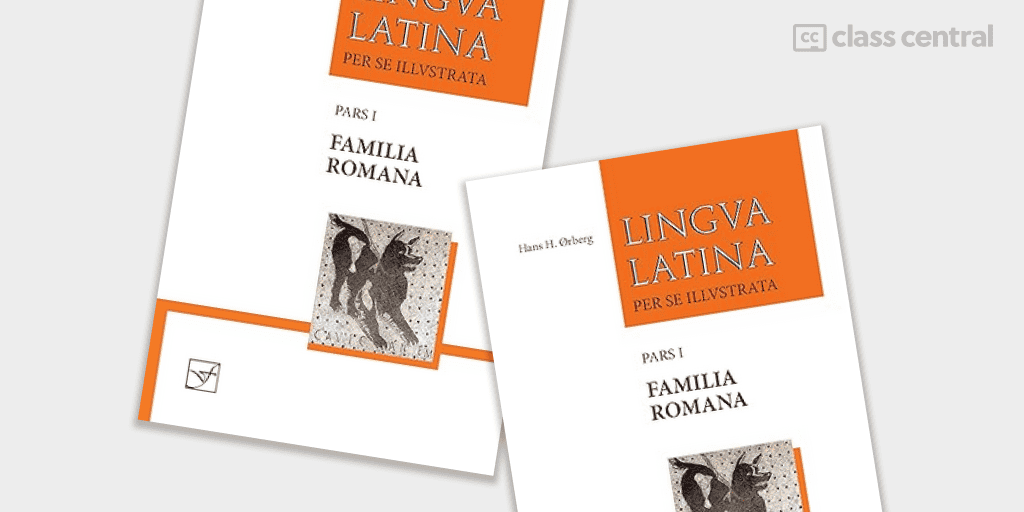
Receiving accolades from many learners, Lingua Latina Per Se Illustrata uses the natural method of language acquisition, immersing learners in Latin without any English translations. It tells the story of a Roman family, gradually introducing more complex grammar and vocabulary.
This approach encourages students to think in the language rather than translating it. By learning grammar and vocabulary inductively through extensive contextual reading, illustrations, and a unique system of marginal notes, students develop a deep understanding of Latin. This method is widely favored by teachers at both secondary and collegiate levels for cultivating Latin conversational skills in the classroom.
In this course, you will learn:
- Comprehensive Latin grammar with detailed explanations and applications in an elementary textbook
- Extensive Vocabulary of nearly 1,800 words reinforced through consistent and creative repetition, enhancing the ability for later sight reading
- Main book with thirty-five chapters depicting the life of a Roman family in the 2nd century A.D.
- Includes readings from classical poets and Donatus’s “Ars Grammatica”
- Each chapter is divided into lessons, a grammar section, and three exercises.
Additional resources include a table of declensions, Roman calendar, and word index. Ancillary volumes, exercises, and readers are available in print and online.
Complete beginners might find this book challenging without a tutor, but if you’re willing to put the time into reading and re-reading the text and examining the illustrations and sidebar notes, you will definitely learn Latin immersively. Combining this book with other resources in this Best Courses Guide would be the best approach.
“This may be the best way to learn Latin. It’s certainly the way that is working best for me…Way more fun than memorizing tables of declensions and conjugations. Although, I confess I don’t know if it would be quite so easy had I not memorized and reviewed much of that info in the past…” – Anonymous Amazon customer.
| Publisher | Hackett Publishing Company |
| Author | Hans H. Ørberg |
| Workload | 328 pages (part 1) |
| Rating | Amazon 4.8/5.0 (1.7K) Goodreads 4.6/5.0 (924) |
| Cost | Paid |
| Quizzes/Assessment Items | Not available |
| Certificate | Not available |
More Free Resources
Improve your vocabulary with:
- Duolingo Latin (2.1M users)
- Latin Word of the Day.
There are several YouTube channels with Latin videos, including:
- ScorpioMartianus: check out the playlist of Latin numbers
- polýMATHY: a range of topics, including Latin and ancient Greek
- Latinum Institute: several playlists, particularly The London Latin Course.
And if you have questions about Latin or translations, Reddit’s r/latin has an active community of 98K members.
Why You Should Trust Us
Class Central, a Tripadvisor for online education, has helped 60 million learners find their next course. We’ve been combing through online education for more than a decade to aggregate a catalog of 200,000 online courses and 200,000 reviews written by our users. And we’re online learners ourselves: combined, the Class Central team has completed over 400 online courses, including online degrees. I’ve personally completed over 200 online courses in a variety of topics.
How We Made Our Picks and Tested Them
Trying to find “the best” can be daunting, even for those of us who live and breathe online courses. Here’s how I approached this task.
First, I combed through Class Central’s Catalog and the internet to find a variety of free and paid open courses, some with certificates. You don’t need to enroll in a university to learn Latin.
When choosing courses, I considered the following factors:
- Renowned Institutions: I looked for recognized institutions and instructors in Latin, with engaging presentation styles
- Popularity: I checked numbers of enrollments and views to find popular resources
- Course content: I examined resources that covered a range of topics and presentation styles. I watched some course videos to sample courses
- Learner reviews: I read learner reviews (when available) to get a sense of the quality of each resource, leveraging the Class Central database with its thousands of ratings and reviews written by our users as well as available course provider reviews.
Then, I defined the scope for these recommendations and used a combination of data and my own judgment to make these picks. I’m confident these recommendations will be a reliable way to learn Latin.








